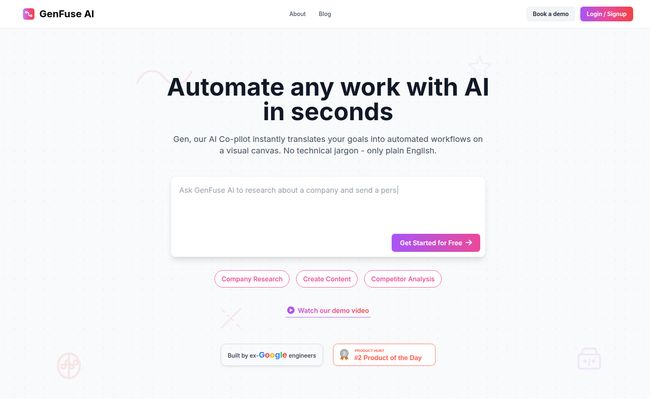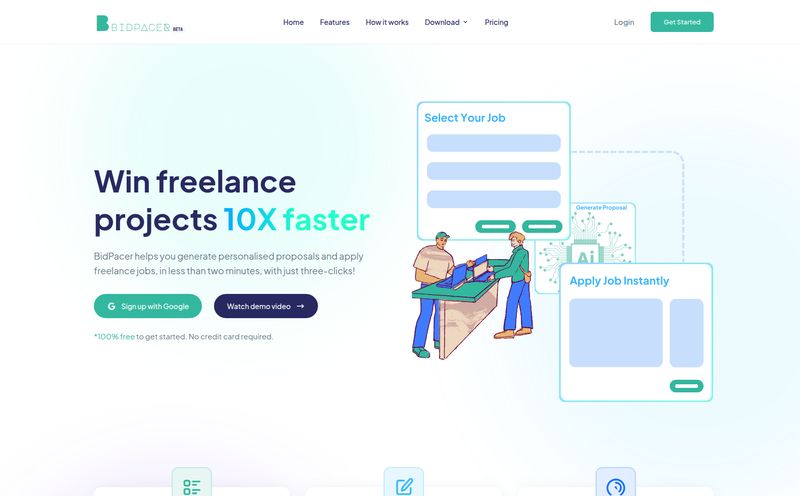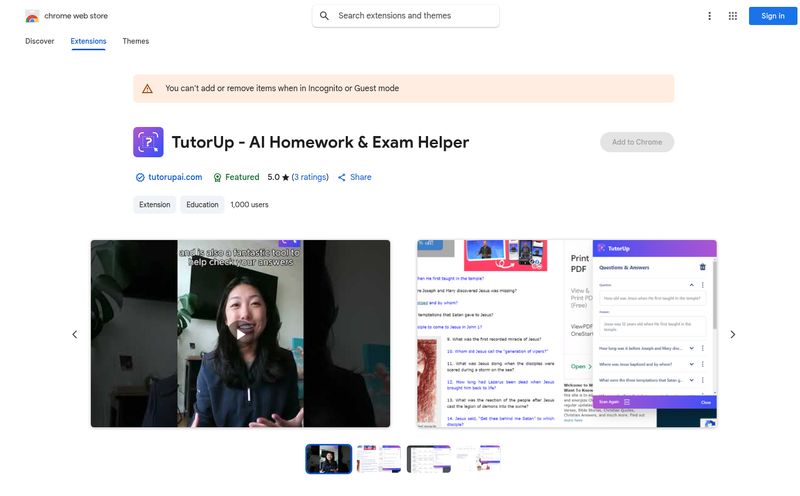As someone who’s been neck-deep in the SEO and digital marketing world for more years than I’d care to admit, I’ve seen my fair share of “game-changing” tools. Most of them promise to revolutionize your workflow, but end up just being another subscription that requires a PhD in API documentation to get working. We've all been there, right? Spending a whole Tuesday afternoon trying to get a simple webhook to fire, only to realize you missed a single comma in a JSON payload. The frustration is real.
So, when the new wave of AI-powered, no-code platforms started popping up, I was… skeptical. It all sounded a bit too good to be true. But the promise of moving beyond rigid, step-by-step automation into something more intelligent and adaptive is just too tempting to ignore. And that’s what led me down the rabbit hole to a tool called GenFuse AI.
What Exactly is GenFuse AI? (And Why Should You Care?)
At its heart, GenFuse AI is a no-code AI agent builder. But that's a bit of a mouthful, isn't it? Let’s break it down. Think of it less like a traditional automation tool and more like a hiring platform for a team of incredibly smart, incredibly fast digital employees. You don't just tell them, "When X happens, do Y." Instead, you give them a goal, and they figure out the steps to get there. It’s a subtle but massive shift in thinking.
You can literally describe a task in plain English—like, “Research this new lead, find their company's recent news, and draft a personalized outreach email”—and the AI builds the entire workflow for you. It's designed to automate complex business operations, the kind of stuff that usually involves multiple apps and a lot of human brainpower. The fact that it was built by ex-Google engineers gives it a certain gravitas, but the real proof is always in the pudding.

Visit GenFuse AI
Moving Beyond Simple "If This, Then That" Logic
For years, platforms like Zapier and IFTTT have been the go-to for automation. And look, they're great for what they do. I still use them for simple, linear tasks. “If I publish a blog post, share it on Twitter.” Simple. Effective. Done.
But what if your task is more… squishy? What if it requires a bit of judgment? That’s where these legacy tools hit a wall. They operate on rigid, pre-defined rules. They can't reason or adapt. If one step in the chain breaks, the whole thing grinds to a halt.
GenFuse AI aims for something different. It’s about creating entire workflows handled by AI agents that can think. Let me give you a more concrete example. Instead of just adding a new lead to a spreadsheet, you could build a GenFuse agent team to:
- Instantly capture a lead from your website form.
- Have one agent research the lead's company on LinkedIn and recent news articles.
- Have another agent analyze the original inquiry to gauge intent and urgency.
- A third agent could then draft a highly personalized welcome email, referencing the research.
- Finally, it creates a task in your CRM, assigns it to a sales rep, and sends a summary to your team's Slack channel.
That’s not an automation; that's a delegated process. And you build it without writing a single line of code.
The Core Features That Caught My Eye
I’m a features guy. The big promises are nice, but I want to know what’s under the hood. A few things about GenFuse AI really stood out to me.
A Truly No-Code Visual Builder
This is the big one. The ability to just tell the AI what you want is the holy grail for so many businesses. It lowers the barrier to entry to almost zero. If you can write an email to a colleague explaining a task, you can build an automation in GenFuse. For those of us who like a bit more control (guilty as charged), there's also a visual canvas where you can see the workflow the AI created and tweak it. It’s the best of both worlds: simplicity up front, with depth available when you need it.
The Magic of Self-Learning Agents
This part feels a little like science fiction. GenFuse claims its agents are "self-learning." In my experience, this means they improve over time based on the outcomes of their tasks. Did a certain style of outreach email get a better response rate? The agent can learn that and adjust its approach. This is a monumental leap from the static, unchanging rules of older platforms. Your automations get smarter and more effective the more you use them, which is a fantastic concept.
Integrations Galore (Over 2500 of Them)
An automation tool is completely useless if it doesn't talk to the apps you actually use every day. With over 2500 integrations, GenFuse AI connects to pretty much everything in the modern tech stack—Google Suite, Slack, HubSpot, Salesforce, you name it. This is table stakes for any serious contender in this space, and they’ve clearly done their homework here.
Being "Model Agnostic" is a Bigger Deal Than You Think
Here’s a slightly more nerdy point, but it's important. GenFuse is "model agnostic." This means it isn’t permanently tied to one AI model like OpenAI's GPT-4 or Google's Gemini. Why does this matter? Because the AI world is moving at a breakneck pace. A new, better, or cheaper model could be released tomorrow. Being model agnostic gives you the flexibility to plug in the best AI for the job, future-proofing your workflows and preventing you from being locked into a single ecosystem. I’ve seen enough companies get burned by vendor lock-in to know that this is a huge plus.
Let's Get Real: The Potential Downsides
No tool is perfect, and it’s important to go in with your eyes open. Based on my analysis and experience with similar platforms, here are a few things to keep in mind about GenFuse AI.
- It Requires Thoughtful Setup: While it's "no-code," it's not "no-thought." You can't just press a button and have it magically fix your chaotic processes. The old saying "garbage in, garbage out" is doubly true for AI. You need to have a clear understanding of the workflow you want to automate for the agents to be effective.
- Effectiveness Depends on Data: The quality of your AI agents' work will directly reflect the quality of the data and instructions you provide. If your CRM is a mess or your process documents are unclear, the AI will struggle. It's a powerful tool, not a miracle worker.
- Reliance on Third-Party Models: Being model agnostic is great, but it still means you're relying on external AI providers like OpenAI or Anthropic. If their API has an outage, your agents might be temporarily impacted. This is a risk inherent to almost every AI tool on the market today, but it’s worth being aware of.
So, How Much Does GenFuse AI Cost?
Ah, the million-dollar question. As of writing this, GenFuse AI does not have a public pricing page. This is pretty common for more specialized B2B SaaS tools that are targeting businesses rather than individual hobbyists. They typically want to have a conversation with you, understand your specific needs, and provide a custom quote.
My advice? Don't let the lack of a pricing page scare you off. If the problems this tool solves resonate with you, the best path forward is to use the "Book a demo" option on their website. It's the quickest way to get a real sense of the platform and find out if the cost aligns with the value it could bring to your operations.
The Final Verdict: Is GenFuse AI for You?
After digging in, I’m genuinely optimistic. GenFuse AI feels like it's on the right track, targeting a real and painful problem: the gap between simple automation and the complex, multi-step processes that eat up most of our time.
This tool is likely a fantastic fit for small to medium-sized businesses, marketing teams, and operations managers who are drowning in manual tasks but don't have the developer resources to build custom internal tools. If you find yourself thinking, “I wish I could just hire a junior person to handle all this admin work,” then GenFuse AI is probably for you.
Who isn't it for? If your needs are super simple—like just posting to social media—a basic tool might be enough. But if you’re looking to build intelligent systems that can take entire processes off your plate, this is a very, very interesting contender. It’s a move from simple automation to intelligent delegation. And that, to me, is where the future of work is headed.
Frequently Asked Questions about GenFuse AI
Is GenFuse AI really no-code?
Yes, for the most part. The core idea is that you can build complex automations by describing them in plain English. While there is a visual editor for more advanced customization, you don't need to write any programming code to create and deploy the AI agents.
How does GenFuse AI differ from tools like Zapier?
Zapier and similar tools are excellent for simple, linear, "if-then" automations. GenFuse AI is built for more complex, multi-step workflows that require reasoning, data gathering, and adaptation. It builds a 'team' of AI agents that can handle a process, rather than just connecting two apps.
Are the AI agents secure with my company's data?
Security is a major concern with any AI tool. GenFuse AI, like any reputable platform, will have security protocols in place. For specific details on their data handling, privacy policies, and security measures, it's always best to consult their official documentation or ask them directly during a demo.
What kind of tasks can I automate with GenFuse AI?
The possibilities are broad, but good examples include automated client onboarding, lead enrichment and personalized outreach, content creation and repurposing, complex data entry and synchronization, and managing your inbox on autopilot.
Do the AI agents really learn and improve?
Yes, this is one of the key features. The agents are designed to analyze the results of their actions and adapt their future behavior to be more effective. This is a significant advantage over static automation rules that never change.
Reference and Sources
Ultimately, the goal of any great technology should be to free up human creativity. We shouldn’t be spending our days copying and pasting data. We should be strategizing, creating, and connecting. If tools like GenFuse AI can help us offload the robotic work to actual robots, then I'm all for it. It might just be the ticket to getting back our most valuable resource: time.



